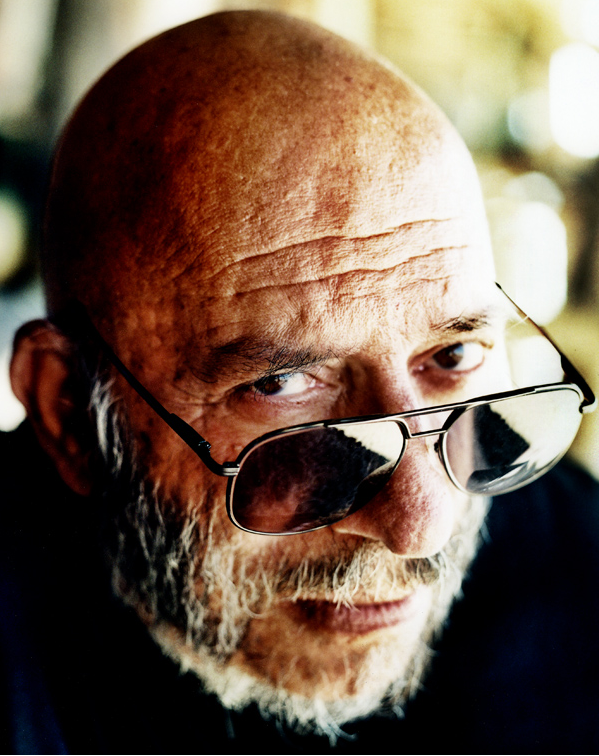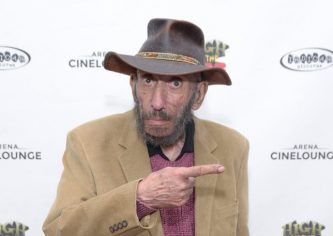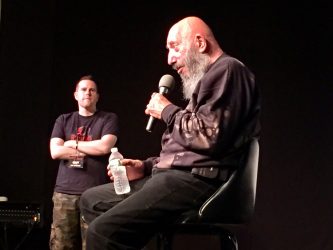 Oftentimes it can be difficult to grasp just how much a skilled supporting player adds to the movies s/he graces—until, that is, the player in question is no longer with us. Such was the case with the great Dick Miller, who after a six decade career as a supporting actor in over 200 films and TV programs passed away earlier this year, making us realize just how valuable his presence was now that we’ll no longer be seeing it (although an excellent biography of the man appeared in late ‘18, courtesy of author Caelum Vatsndal). In the same league was Sid Haig, who died on September 21. Haig’s career as a supporting actor was nearly as long as Miller’s, and just as wide-ranging (a biography about him, alas, has yet to be written).
Oftentimes it can be difficult to grasp just how much a skilled supporting player adds to the movies s/he graces—until, that is, the player in question is no longer with us. Such was the case with the great Dick Miller, who after a six decade career as a supporting actor in over 200 films and TV programs passed away earlier this year, making us realize just how valuable his presence was now that we’ll no longer be seeing it (although an excellent biography of the man appeared in late ‘18, courtesy of author Caelum Vatsndal). In the same league was Sid Haig, who died on September 21. Haig’s career as a supporting actor was nearly as long as Miller’s, and just as wide-ranging (a biography about him, alas, has yet to be written).
I, like quite a few film buffs the world over, have come to know Haig primarily for his appearances in the many horror-exploitation films he graced. Yet upon perusing his filmography I was astonished to find out just how ubiquitous he truly was. Nearly every TV show I favored as a child (BATMAN, STAR TREK, EMERGENCY!, THE SIX MILLON DOLLAR MAN, ELEKTRA WOMAN AND DYNA GIRL, THE A-TEAM, AUTOMAN, MISFITS OF SCIENCE, SLEGE HAMMER!) contained one or more guest appearances by Mr. Haig, who also turned up in quite a few seminal non-exploitation themed films (POINT BLANK, THX-1138, DIAMONDS ARE FOREVER). Other noteworthy appearances occurred in the renowned trash movies of Jack Hill (THE HOST, SPIDER BABY, PIT STOP, THE BIG DOLL HOUSE, THE BIG BIRD CAGE, COFFY, FOXY BROWN), a fact that by itself is enough to ensure Haig a permanent place in some kind of cinematic hall of fame.
Haig summed up his life and career thusly: “Was I a successful father? Maybe not. Was I successful husband? Probably not. Was I a  successful actor? Probably not.” Such refreshing self-deprecation was and is the mark of many a longtime supporting actor, who tend to evince a humility their movie star colleagues generally lack, as well as a practical nuts-and-bolts approach to their craft (of his appearance in the 1973 Filipino sleazer WONDER WOMEN, Haig claims it was “One of those films I did because I was there”). Unpretentious frankness was always evident in Haig’s public pronouncements, which occasionally veered into brutally frank territory, as in a 1990s-era Shock Cinema interview in which he offered the following opinion on his fellow thespians: “there’s not a lot of actors out there. There’s a lot of people who stand in front of cameras and say words, but there’s not a lot of actors.”
successful actor? Probably not.” Such refreshing self-deprecation was and is the mark of many a longtime supporting actor, who tend to evince a humility their movie star colleagues generally lack, as well as a practical nuts-and-bolts approach to their craft (of his appearance in the 1973 Filipino sleazer WONDER WOMEN, Haig claims it was “One of those films I did because I was there”). Unpretentious frankness was always evident in Haig’s public pronouncements, which occasionally veered into brutally frank territory, as in a 1990s-era Shock Cinema interview in which he offered the following opinion on his fellow thespians: “there’s not a lot of actors out there. There’s a lot of people who stand in front of cameras and say words, but there’s not a lot of actors.”
Sid Haig wasn’t what you’d call a marquee idol. He was balding, pockmarked and had a rather off-putting presence. That explains why, despite having trained at the prestigious Pasadena Playhouse (whose other alums include Gene Hackman and Dustin Hoffman) and evinced an undeniable acting prowess, he never attained leading man status—and also why, of the parts Haig did play, so many of them were heavies. He was apparently never too happy with this state of affairs, and famously quit the business in 1992, proclaiming that “I just didn’t want to play stupid heavies anymore, they just kept giving me the same parts but putting different clothes on me.”
 That retirement didn’t last long. Quentin Tarantino wrote the part of a judge who sentences Pam Grier in 1997’s JACKIE BROWN specifically for Haig (who had appeared with Grier in BLACK MAMA WHITE MAMA and many of the aforementioned Jack Hill pictures), and he had no compunctions about taking the role (having already turned down the part of Marcellus Wallace in PULP FICTION, which he later called his greatest professional regret). Nor did he hesitate to accept an offer to play Captain Spaulding, a homicidal psychopath not too far removed from the bad guy roles for which he was known, in Rob Zombie’s HOUSE OF 1,000 CORPSES (released in 2003 but filmed three years earlier). That of course provided the sixtyish Haig with renewed success and a new fan base.
That retirement didn’t last long. Quentin Tarantino wrote the part of a judge who sentences Pam Grier in 1997’s JACKIE BROWN specifically for Haig (who had appeared with Grier in BLACK MAMA WHITE MAMA and many of the aforementioned Jack Hill pictures), and he had no compunctions about taking the role (having already turned down the part of Marcellus Wallace in PULP FICTION, which he later called his greatest professional regret). Nor did he hesitate to accept an offer to play Captain Spaulding, a homicidal psychopath not too far removed from the bad guy roles for which he was known, in Rob Zombie’s HOUSE OF 1,000 CORPSES (released in 2003 but filmed three years earlier). That of course provided the sixtyish Haig with renewed success and a new fan base.
It was that post-2003 renaissance for which, I’m guessing, most of you know Sid Haig best. Having apparently put aside his compunction about playing heavies, he became a fixture at horror conventions and appeared in a ton of substandard horror themed no-budgeters, from NIGHT OF THE LIVING DEAD 3D to BROTHERHOOD OF BLOOD to DEATH HOUSE, in which he generally played (you guessed it) a heavy. If you haven’t seen those films (or THE PENNY DREADFUL SHOW, HATCHET III or ZOMBEX) don’t feel bad, as, Haig’s spirited emoting aside, you haven’t missed much. It’s certainly a fact that a skilled actor can help to elevate a good movie, but when a movie sucks there’s not much even the best actor can do to prop it up (check any of the crappy Robert De Niro headlined post-00 movies if you don’t believe me).
Haig also turned up a few legitimately good movies in his later years, such as KILL BILL VOLUME 2, as well as nearly the entire  filmography of Rob Zombie, which includes the soon-to-be-released 3 FROM HELL (in which Haig’s presence was severely reduced, reportedly due to health issues). His final film appearance was in HANUKKAH, yet another low budget horror film, albeit one that also happens to feature the aforementioned Dick Miller in what was likewise his last-ever appearance.
filmography of Rob Zombie, which includes the soon-to-be-released 3 FROM HELL (in which Haig’s presence was severely reduced, reportedly due to health issues). His final film appearance was in HANUKKAH, yet another low budget horror film, albeit one that also happens to feature the aforementioned Dick Miller in what was likewise his last-ever appearance.
What can we learn from the Sid Haig saga? I’d say plenty, starting with the fact that, quite simply, SPIDER BABY, WONDER WOMEN, ELECTRA WOMAN AND DYNA GIRL, FOXY BROWN and HOUSE OF 1,000 CORPSES would have all been greatly lessened without Haig’s inimitable presence.
